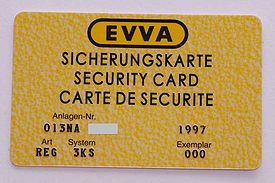Security card: Difference between revisions
mNo edit summary |
mNo edit summary |
||
| Line 14: | Line 14: | ||
== Gallery == | == Gallery == | ||
<div align="center"><gallery> | <div align="center"><gallery> | ||
File:Ikon_TK5_RKS_keycard.jpg|Security card for the [[IKON TK5]]. | |||
</gallery></div> | </gallery></div> | ||
Revision as of 19:18, 20 December 2010
Security Card

A security card (or keycard, key security card) is an object that is required to duplicate or create a given key. The purpose of security cards is to help prevent unauthorized duplication of keys for a given keying system. Many high security locks require a security card be presented to a locksmith before a key can be created or duplicated. This holds true even after patent protection of a given key blank has expired.
Security cards are obtained when the lock is purchased and used whenever additional keys are required. The cards themselves resemble credit cards, though not all contain magnetic strips. They contain the direct or indirect bitting code of the lock, the keyway profile, master keying data, and other important information on the face of the card. Many cards try to avoid this by embedding the information in the card itself, usually with a magnetic strip. More advanced cards may store auditing information (either locally or on a remote system) each time the card is used to duplicate or create a working key for the lock.
Security considerations
Because they contain as much, and sometimes more, sensitive information as keys, security cards are subject to all of the same security precautions. Cards with direct codes can be visually decoded, and those that use magnetic strips are subject to reading and duplication with the proper tools. At the same time, an unscrupulous locksmith can duplicate keys without proper authorization.
Gallery
Security card for the IKON TK5.
